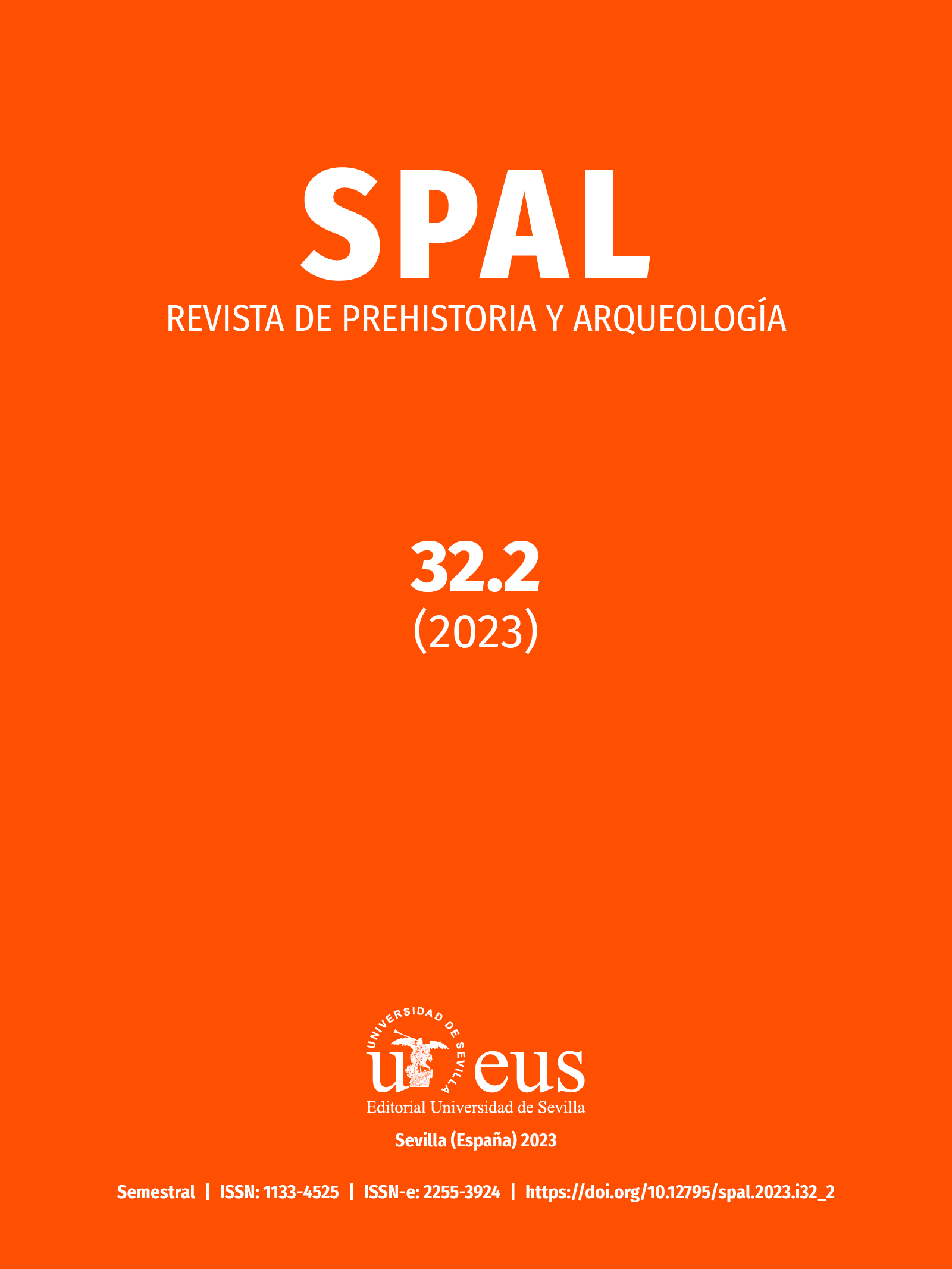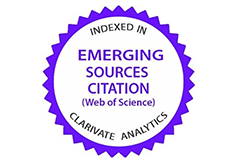A lasting bond: on a transferred death ritual from ancient Cynopolis
DOI:
https://doi.org/10.12795/spal.2023.i32.20Palabras clave:
Figurillas, prácticas mágico-religiosas, iconografía, materialidad, Egipto greco-romanoResumen
This paper seeks to analyse two groups of reddish wax magic figurines discovered in the cemetery of the ancient city of Cynopolis and preserved at the Antiquities Museum of the Bibliotheca Alexandrina, with the aim of offering a critical and updated exegesis of these exceptional magical artefacts from Roman Egypt. By analysing features including material, colour, morphology and iconography, and by examining the effigies alongside parallel rituals, I argue that this ensemble should be best understood as a ‘transferred death ritual’, whose aim was to ensure an effective death and the sending of the deceased to the underworld.
Descargas
Citas
Alfayé Villa, S. (2016) “Los temores del mago: miedos en torno a la acción mágica en la antigua Roma”, ARYS. Antigüedad: Religiones y Sociedades, 14, pp. 109-152. https://doi.org/10.20318/arys.2017.3988
Allen, T. G. (1974) The Book of the Dead or Going Forth by Day. Ideas of the Ancient Egyptians Concerning the Hereafter as Expressed in their Own Terms, Studies in Ancient Oriental Civilization, 37. Chicago: The Oriental Institute of the University of Chicago.
Brashear, W. M. (1992) “Ein neues Zauberensemble in München”, Studien zur Altägyptischen Kultur, 19, pp. 79-109.
Collins, D. (2008) “Mapping the Entrails: The Practice of Greek Hepatoscopy”, The American Journal of Philology, 129 (3), pp. 319-345.
Colonna, A. (2021) Religious Practice and Cultural Construction of Animal Worship in Egypt from the Early Dynastic to the New Kingdom. Rituals forms, material display, historical development, Archaeopress Egyptology, 36. Oxford: Archaeopress.
Corcoran, L. H. (1995) Portrait Mummies from Roman Egypt (I-IV Centuries A.D.) with a Catalog of Portrait Mummies in Egyptian Museums, Studies in Ancient Oriental Civilization, 56. Chicago: The Oriental Institute of the University of Chicago.
Curbera, J. (2015) “From the Magician’s Workshop: Notes on the Materiality of Greek Curse Tablets”, in Boschung, D. and Bremmer, J. N. (eds.) The Materiality of Magic. Cologne 2012. Paderborn: Wilhelm Fink Verlag, pp. 97-122.
Daressy, M. G. (1902) Catalogue général des antiquités égyptiennes du Musée du Caire: fouilles de la Vallée des Rois (1898-1899). Cairo: Imprimerie de l’Institut français d’archéologie orientale.
Derchain, P. (1965) Le Papyrus Salt 825 (B.M. 10051), rituel pour la conservation de la vie en Égypte. Brussels: Palais des Académies.
Diosono, F. (2020) “Lamps as Ritual and ‘Magical’ Objects in Archaeological Contexts”, in Mastrocinque, A., Sanzo, J. E. and Scapini, M. (eds.) Ancient Magic: Then and Now, Potsdamer Altertumswissenschaftliche Beiträge, 74. Meran 2016. Stuttgart: Franz Steiner Verlag, pp. 139-157.
Dosoo, K. (2022) “Two Body Problems: Binding Effigies in Christian Egypt and Elsewhere”, in Johnston, J. and Gardiner, I. (eds.) Drawing the Spirit: The Role of Images and Design in the Magical Practice of Late Antiquity. Berlin-Boston: De Gruyter, pp. 135-184. https://doi.org/10.1515/9783110479201-006
DT = Audollent, A. (1904) Defixionum Tabellae: quotquot innotuerunt tam in Graecis Orientis quam in totius occidentis partibus praeter Atticas. Paris: Alberti Fontemoing.
DuQuesne, T. (1996a) Black and Gold God. Colour symbolism of the god Anubis with observations on the phenomenology of colour in Egyptian and comparative religion, Oxfordshire Communications in Egyptology, 5. London: Darengo Publications.
DuQuesne, T. (1996b) “Anubis Master of Secrets (ḥry-šst3) and the Egyptian Conception of Mysteries”, Discussions in Egyptology, 36, pp. 25-38.
DuQuesne, T. (2005) The Jackal Divinities of Egypt I: From the Archaic Period to Dynasty X, Oxfordshire Communications in Egyptology, 6. London: Darengo Publications.
DuQuesne, T. (2012) Spirits of the West, Oxfordshire Communications in Egyptology, 8. London: Darengo Publications.
Durisch Gauthier, N. (2002) Anubis et les territoires cynopolites selon les temples ptolémaïques et romains. Doctoral thesis. University of Genova. Available in: https://archive-ouverte.unige.ch/unige:27006 (Consulted: 18 May 2023).
Edwards, I. E. S. (1976) Tutankhamun: His Tomb and Its Treasures. New York: The Metropolitan Museum of Art.
Eidinow, E. (2007) Oracles, Curses, and Risk Among the Ancient Greeks. Oxford: Oxford University Press.
Étienne, M. (2000) Heka. Magie et envoûtement dans l’Égypte ancienne, Exposition-dossier du département des Antiquités égyptiennes, 57. Paris: Réunion des Musées Nationaux.
Faraone, C. A. (1991a) “Binding and Burying the Forces of Evil: The Defensive Use of ‘Voodoo Dolls’ in Ancient Greece”, Classical Antiquity, 10 (2), pp. 165-205, 207-220.
Faraone, C. A. (1991b) “The Agonistic Context of Early Greek Binding Spells”, in Faraone, C. A. and Obbink, D. (eds.) Magika Hiera: Ancient Greek Magic and Religion. New York-Oxford: Oxford University Press, pp. 3-32.
Faulkner, R. O. (1937). “The Bremner-Rhind Papyrus-III”, The Journal of Egyptian Archaeology, 23 (2), pp. 166-185.
Fermat, A. (2010) Le ritual de la maison de vie. Papyrus Salt 825. Paris: MdV Éditeur.
Fitzenreiter, M. (ed.) (2003) Tierkulte im pharaonischen Ägypten und im Kulturvergleich. Beiträge eines Workshops am 7.6. und 8.6.2002, Internet-Beiträge zur Ägyptologie und Sudanarchäologie 4. Berlin 2002. London: Golden House Publications.
Gager, J. G. (1992) Curse Tablets and Binding Spells from the Ancient World. New York-Oxford: Oxford University Press.
GEMF = Faraone, C. A. and Torallas Tovar, S. (2022) Greek and Egyptian Magical Formularies: Text and Translation, vol. I. Berkeley: California Classical Studies.
Goedicke, H. (1963) “Was Magic Used in the Harem Conspiracy against Ramesses III? (P.Rollin and P.Lee)”, The Journal of Egyptian Archaeology, 49, pp. 71-92.
Grenier, J-C. (1977) Anubis alexandrin et romain, Études préliminaires aux religions orientales dans l’Empire romain, 57. Leiden: Brill.
Griffiths, J. G. (1972) “The Symbolism of Red in Egyptian Religion”, in Bleeker, C. J., Brandon, S. G. F. and Simon, M. (eds.) Ex orbe religionum. Studia Geo Widengren xxiv mense Aprili mcmlxxii quo die lustra tredecim feliciter explevit oblata ab collegis, discipulis, amicis, collegae magistro amico congratulantibus. Pars prior, Numen Book Series: Studies in the History of Religions, 22. Leiden: Brill, pp. 81-90.
Guida, G. and Talarico, F. (2002) “Le figurine antropomorfe e i loro contenitori: i materiali costitutivi”, in Piranomonte, M. (ed.) El santuario della musica e il bosco sacro di Anna Perenna. Rome: Electa, pp. 53-57.
Haggag, M. (2004) “Some Unpublished Wax Figurines from Upper Egypt”, in Harris, W. V. and Ruffini, G. (eds.) Ancient Alexandria Between Egypt and Greece, Columbia Studies in the Classical Tradition, 26. Leiden-Boston: Brill, pp. 231-240.
Hanses, M. (2022) “Ovid and the Magic Doll: Witchcraft and Defixiones in Amores 3.7”, Classical Journal, 117 (3), pp. 249-283. https://doi.org/10.1353/tcj.2022.0000
Homer (1928) The Iliad, volume I: Books 1-12 (Murray, A. T. trans.), Loeb Classical Library, 170. London-New York: Harvard University Press.
Ikram, S. (ed.) (2005) Divine Creatures. Animal Mummies in Ancient Egypt. Cairo-New York: The American University in Cairo Press.
Jordan, D. R. (1988) “New Archaeological Evidence for the Practice of Magic in Classical Athens”, in Praktika of the 12th International Congress of Classical Archaeology, Athens, 4-10 September 1983, vol. 4. Athens 1983. Athens: Hypourgeion Politismou kai Epistēmōn, pp. 273-277.
Kaper, O. E. (1993) “The Door Sealings and Object Sealings”, in Baines, J. (ed.) Stone Vessels, Pottery and Sealings From the Tomb of Tut’ankhamūn. Oxford: Griffith Institute, Ashmolean Museum, pp. 139-177.
Kees, H. (1943) “Farbensymbolik in ägyptischen religiösen Texten”, Nachrichten der Akademie der Wissenschaften zu Göttingen, Philologisch-Historische Klasse, 11, pp. 413-479.
Lefevbre, G. (1949) “Rouge et nuances voisines”, The Journal of Egyptian Archaeology, 35, pp. 72-76.
Lewis, S. and Llewellyn-Jones, L. (2018) The Culture of Animals in Antiquity: A Sourcebook with Commentaries. London-New York: Routledge.
Marco Simón, F. (2009) “Tradite manibus: transferred death in magical rituals”, in Marco, F., Pina, F. and Remesal, J. (eds.) Formae mortis. El tránsito de la vida a la muerte en las sociedades antiguas, Colección instrumenta, 30. Zaragoza 2007. Barcelona: Universidad de Barcelona, pp. 165-180.
Marco Simón, F. and Sánchez Natalías, C. (2022) “Images of Tied Victims in Magical Texts”, in Martín Hernández, R. (ed.) The Iconography of Magic. Images of Power and the Power of Images in Ancient and Late Antique Magic, Studies in the History and Anthropology of Religion, 7. Madrid 2016. Louvain: Peeters Publishers, pp. 15-34.
Martín Hernández, R. (2021) “The Figural Representation of Victims on Agonistic Late-Antique Curse Tablets”, Religion in the Roman Empire, 7 (1), pp. 96-124. 10.1628/rre-2021-0009
Mastrocinque, A. (2007) “Late Antique Lamps with Defixiones”, Greek, Roman, and Byzantine Studies, 47, pp. 87-99.
Montet, P. (1961) Géographie de l’Égypte ancienne. Deuxième partie. To-chemâ. La Haute Égypte. Paris: Libraire C. Klincksieck.
Ogden, D. (2002) Magic, Witchcraft, and Ghosts in the Greek and Roman Worlds: A Sourcebook. Oxford: Oxford University Press.
Ovid (1995) Amores, Medicamina faciei femineae, Ars Amatoria, Remedia amoris (Kenney, E- J. trans.), Oxford Classical Texts. Oxford-New York: Oxford University Press.
Pastoreau, M. (2017) Red: The History of a Color. Princeton-Oxford: Princeton University Press.
Pinch, G. (1994) Magic in Ancient Egypt. London: The British Museum Press.
Pinch, G. (2001) “Red things: the symbolism of colour in magic”, in Davies, W. V. (ed.) Colour and Painting in Ancient Egypt. London 1996. London: The British Museum Press, pp. 182-185.
Piranomonte, M. (2005) “La fontana sacra di Anna Perenna a Piazza Euclide tra religione e magia”, MHNH: revista internacional de investigación sobre magia y astrología antiguas, 5, pp. 87-104.
Piranomonte, M. (2010) “Religion and Magic at Rome: The Fountain of Anna Perenna”, in Marco Simón, F. and Gordon, R. L. (eds.) Magical Practice in the Latin West, Religions in the Graeco-Roman World, 168. Zaragoza 2005. Leiden-Boston: Brill, pp. 191-213.
Piranomonte, M. (2015) “The discovery of the Fountain of Anna Perenna and its Influence on the Study of the Ancient Magic”, in Bakowska-Czerner, G., Rocatti, A. and Świerowska, A. (eds.) The wisdom of Thoth: Magical Texts in Ancient Mediterranean Civilisations. Kraków 2013. Oxford: Archaeopress, pp. 71-85.
PGM = Betz, H. D. (1986) The Greek Magical Papyri in Translation Including the Demotic Spells. Chicago-London: The University of Chicago Press.
Posener, G. (1949) “Les Signes noirs dans les rubriques”, The Journal of Egyptian Archaeology, 35, pp. 77-81.
Pouls Wegner, M.-A. (2007) “Wepwawet in Context: A Reconsideration of the Jackal Deity and Its Role in the Spatial Organization of the North Abydos Landscape”, Journal of the American Research Center in Egypt, 43, pp. 139-150.
Rapinesi, I. A. and Polakova, J. (2002) “I materiali magici”, in Piranomonte, M. (ed.) Il santuario della musica e il bosco sacro di Anna Perenna. Milan: Electa, pp. 38-52.
Rapinesi, I. A. and Polakova, J. (2012) “La conservazione dei materiali magici del santuario di Anna Perenna. Il restauro”, in Marco, F. and Piranomonte, M. (eds.) Contesti magici/Contextos mágicos. Rome 2009. Rome: De Luca Editori d’Arte, pp. 175-182.
Raven, M. (1983) “Wax in Egyptian Magic and Symbolism”, Oudheidkundige mededelingen uit het Rijksmuseum van Oudheden te Leiden, 64, pp. 7-47.
Ritner, R. K. (1993) The Mechanics of Ancient Egyptian Magical Practice, Studies in Ancient Oriental Civilization, 54. Chicago: The Oriental Institute of the University of Chicago.
Sánchez Natalías, C. (2015) “Magical Poppets in the Western Roman Empire: a Case Study from the Fountain of Anna Perenna”, in Minniyakhmetova, T. and Velkoborská, K. (eds.) The Ritual Year 10: Magic in Rituals and Rituals in Magic. Inssbruck 2014. Innsbruck: ELM Scholarly Press, pp. 194-202.
Sánchez Natalías, C. (2020) “Seth in the Fountain of Anna Perenna? A New Interpretation of the Container 475549”, in Mastrocinque, A., Sanzo, J. E. and Scapini, M. (eds.) Ancient Magic: Then and Now, Potsdamer Altertumswissenschaftliche Beiträge, 74. Meran 2016. Stuttgart: Franz Steiner Verlag, pp. 113-122.
Schlörb-Viernesel, B. (1966) “Eridanos-Nekropole I: Gräber und Opferstellen hS 1-204”, Mitteilungen des deutschen archäologischen Instituts, 81, pp. 4-111.
SD = Sánchez Natalías, C. (2022) Sylloge of Defixiones from the Roman West. A Comprehensive Collection of Curse Tablets from the Fourth Century BCE to the Fifth Century CE, BAR International Series, 3077. Oxford: BAR Publishing.
SGD = Jordan, D. R. (1985) “A Survey of Greek Defixiones Not Included in the Special Corpora”, Greek, Roman, and Byzantine Studies, 26, pp. 151-197.
Sharrock, A. R. (1995) “The Drooping Rose: Elegiac Failure in Amores 3.7”, Ramus, 24 (2), pp. 152-180. https://doi.org/10.1017/S0048671X00002253
Simpson, W. K. (1973) “Ptolemaic-Roman Cartonnage Footcases with Prisoners Bound and Tied”, Zeitschrift für Ägyptische Sprache und Altertumskunde, 100 (2), pp. 50-54.
SM = Daniel, R. W. and Maltomini, F. (1999) Supplementum Magicum. Opladen: Westdeutscher Verlag.
Stroszeck, J. (2019) “Unterweltsvorstellungen und die Fundorte von Fluchtafeln im Kerameikos”, in Frielinghaus, H., Stroszeck, J. and Valavanis, P. (eds) Griechische Nekropolen. Neue Forschungen und Funde, Beiträge zur Archäologie Griechenlands, 5. Möhnesse: Bibliopolis, pp. 337-376.
Stroszeck, J. (2021) “The Archaeological Contexts of Curse Tablets in the Athenian Kerameikos”, in Faraone, C. A. and Polinskaya, I. (eds.) Curses in Context III: Greek Curse Tablets of the Classical and Hellenistic Periods, Papers and Monographs from the Norwegian Institute at Athens, 12. Athens 2019. Athens: The Norwegian Institute at Athens, pp. 21-48.
Te Velde (1967) Seth, God of Confusion. A Study of his Role in Egyptian Mythology and Religion. Leiden: Brill.
Trumpf, J. (1958) “Fluchtafel und Rachepuppe”, Mitteilungen des deutschen archäologischen Instituts, 73, pp. 94-102.
Vandier, J. (1972) “Nouvelles acquisitions: Musée du Louvre, département des Antiquités égyptiennes”, La Revue du Louvre et des musées de France, 1972 (2), pp. 89-102.
Veldmeijer, A. J. (2011). “Description”, in Veldmeijer, A. J. (ed.) Tutankhamun’s Footwear: Studies on Ancient Egypian Footwear. Leiden: Sidestone Press, pp. 43-144.
Vila, A. (1963) “Un dépôt de textes d’envoûtement au Moyen Empire”, Journal des Savants, 3, pp. 135-160. https://doi.org/10.3406/jds.1963.1055
Vila, A. (1973) “Un rituel d’envoûtement au Moyen Empire Égyptien”, in Sauter, M. (ed.) L’Homme, hier et aujourd’hui: Recueil d’études en hommage à André Leroi-Gourhan. Paris: Éditions Cujas, pp. 625-639.
Wilburn, A. T. (2012) Materia magica. The Archaeology of Magic in Roman Egypt, Cyprus, and Spain, New Texts from Ancient Cultures. Ann Arbor: University of Michigan Press.
Wilburn, A. T. (2019) “Figurines, Images, and Representations Used in Ritual Practices”, in Frankfurter, D. (ed.) Guide to the Study of Ancient Magic, Religions in the Graeco-Roman World, 189. Leiden-Boston: Brill, pp. 456-506.
Wilfong, T. G. (2015) Death Dogs: The Jackal Gods of Ancient Egypt, Kelsey Museum Publication, 11. Ann Arbor: Kelsey Museum of Archaeology.
Wilfong, T. G. and Ferrara, A. W. S. (2014) Karanis Revealed: Discovering the Past and Present of a Michigan Excavation in Egypt, Kelsey Museum Publication, 7. Ann Arbor: Kelsey Museum of Archaeology.
Wünsch, R. (1902) “Eine antike Rachepuppe”, Philologus, 61, pp. 26-31.
Zografou, A. (2010) “Magic Lamps, Luminous Dreams. Lamps in PGM Recipes”, in Christopoulos, M., Karakantza, E. D. and Levaniouk, O (eds.) Light and Darkness in Ancient Greek Myth and Religion, Greek Studies: Interdisciplinary Approaches. Patras 2007. Lanham: Lexington Books, pp. 276-294.
Descargas
Publicado
Cómo citar
Número
Sección
Licencia
Derechos de autor 2023 SPAL - Revista de Prehistoria y Arqueología

Esta obra está bajo una licencia internacional Creative Commons Atribución-NoComercial-SinDerivadas 4.0.









